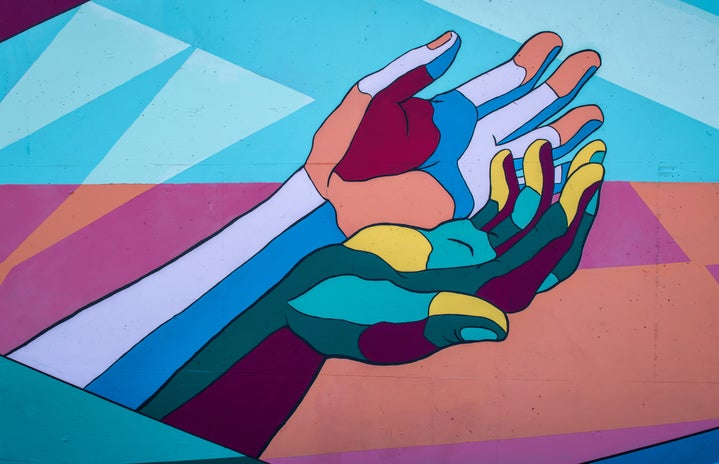At 12:41 a.m. on Sunday, Feb. 28, 2021, vocal and part-time crypto artist, Grimes, welcomed her Twitter followers to “enter the void” of her crypto artwork releasing at 2 p.m. that day. “WarNymph Collection Vol. 1” sold for $5.8 million in 20 minutes on popular crypto art site Nifty Gateway, eclipsing the original 48-hour deadline for the work’s whimsical and extraterrestrial glory.
Crypto art, an art genre with blockchain technology, emerged in the mid-2010s. The most popular of the first crypto artworks is artist Kevin Abosch’s “Bank”, a conceptual book including “500 paired Bitcoin public and private keys in a limited edition book of 50. [Abosch declared] it a bank,” according to Ostachowski.com.
The collection included ten pieces, referred to as non-fungible tokens (NFTs), which are digital, auctionable tokens working as unique and permanent marks of authenticity (think of a signature but in code).
Grimes embodied an intergalactic cherub to explore “the fluidity of identity in the virtual age,” and depict a fearless force battling “obsolete ideas and systemic decay [threatening] the future,” according to the description. Simultaneously, she brought more attention to the eccentric, imaginative, and once niche universe of crypto art.
On Monday, Dec.14, 2020, Turkish researcher and digital artist, Memo Atken, published “The Unreasonable Ecological Cost of #CryptoArt (Part 1)”, an article exposing the negative impact the new art genre has had on the environment in its short existence.
Atken asserts that the carbon footprint due to the energy fueling NFT transactions and the lack of transparency from companies (specifically the blockchain Ethereum [ETH]) are to blame. “While not as bad as Bitcoin, a single [ETH] transaction is estimated to have a footprint on average of around 35 kWh [kilowatt-hour],” and “emissions close to 20 KgCO2 [kilogram carbon dioxide, a greenhouse gas],” Atken said.
For many artists, crypto art granted them millions while simultaneously giving them full ownership of their work—a reality the ‘starving artist’ can only dream of. This digitized renaissance, however, has not only shifted the art world but also the environment. While art auctioneers buy and sell hundreds of thousands per NFT, the Earth is paying with minimal chances of return, soon to be drastically indebted.

From Pixels to kWhs and CO2
According to the data on digiconomist.net, the energy from single transactions is now an estimated 66.55 kWh and 31.61 KgCO2 —almost doubled from the numbers reported in Atken’s article.
To put this into perspective, the monthly average of electricity consumption for the U.S. household is 877 kWh according to the U.S Energy Information Administration. The amount of ETH transactions per day as of March 31 is 1.301 million, a 2.45% increase from the previous day’s number, 1.270M. That is, roughly, 86,581,550 kWh in a day.
Along with the energy from the transaction alone, the “mining” (the process of high-powered computers solving complex mathematical problems to add transactions to the blockchain) necessary for the NFT process can “overload local grids,”. This is 26.5 terawatt-hours (one TWh is one billion kWh) a year, “nearly as much as the entire country of Ireland [with] almost 5 million residents,” according to a Time Magazine article by Alejandro De La Garza.
This data can make it seem like the process of uploading crypto art is difficult, however, it is easier than the percentages make it seem, which some may say is part of the issue. Once an artist gets the gist of uploading their work to a website, the hardest part may be finding someone to buy and or creating the art itself. When that is done, the artists nor the auctioneers have to worry about the energy consumption or computations, hence the number of transactions per day.

“A World that Removes More Carbon than it Emits”
Many are trying to find ways to make crypto art more ethical. Initiatives like GreenNFTs by Artnome use a bounty system to reward people for energy efficiency attempts. A “Guide to ecofriendly CryptoArt (NFTs)” with contributions from Atken and other artists includes tips like using a “sidechain” or altering the method of “minting”. A Discord server, “Clean-NFTs” allows those interested to discuss tips and new information as well.
Grimes also donated some of the sales from “WarNymph Collection Vol. 1” to Carbon180, a non-governmental organization (NGO) dedicated to “fundamentally rethinking carbon,” and “build[ing] a world that removes more carbon than it emits,”.
In an interview with Flash, Atken said that the sustainability issue not only is part of this conversation but is the conversation. Many make a living off of crypto art, whether as a side job or to support their family, adding to the ethicality issue. Artists, however, do not want NFTs to be omitted, instead, simply improved—with no Earth, there are no artists, let alone art.
“Digital artists absolutely should be able to earn a living making the work they love. But this should not involve the immense footprint it does…nor the current lack of transparency. New businesses and platforms must align with the values we are hoping to carry into the future,” Atken said.



